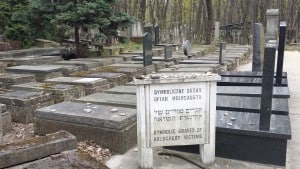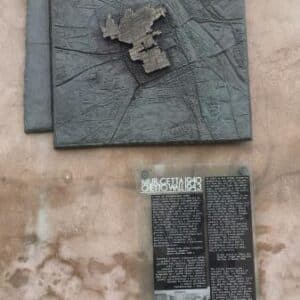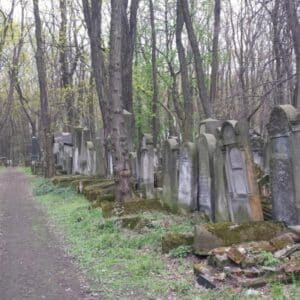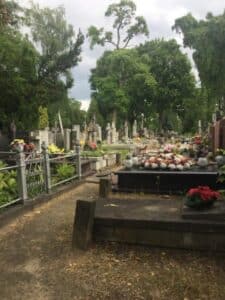Warsaw, a city deeply entwined with Jewish history, hosts two large Jewish cemeteries. Although one is currently still active, both are in states of severe disrepair. The largest of these is the Okopowa Street Jewish Cemetery, one of the largest Jewish burial grounds in Europe. Spanning approximately 33 hectares (about 63 American football fields), it houses over 250,000 graves, dating back to the early 19th century. The second is the Brodno Cemetery, covering about 12 hectares and containing around 150,000 graves.
Devastated under the Nazi occupation and neglected under the communists, efforts to restore these historic sites have been slow but ongoing since about the mid-1980s. Both sites can be visited by interested parties, but one should plan ahead as they are often closed to protect them from vandalism.
Briefly on Jewish Concepts of Death
Jewish cemeteries, known as bet kevarot (“house of graves”) or bet olam (“eternal house”), hold a special place in Jewish tradition. Considered even holier than synagogues, these final resting places are imbued with deep respect and require ongoing care. Maintaining Jewish cemeteries is not just a practical necessity, but a core religious and social responsibility for the Jewish community.
The Talmud, a central text of Rabbinic Judaism, emphasizes the importance of caring for Jewish graves and cemeteries. This tradition is reflected in the way Jewish communities traditionally share the burden of protecting, repairing, and maintaining these sacred grounds. Located at a distance from residential areas, Jewish cemeteries are often marked with signs or fences to alert visitors and passersby to their presence. Respect for the deceased and the holiness of the place is paramount. Visitors are expected to dress modestly, avoid frivolous behavior, and wash their hands upon leaving the cemetery grounds.
The sanctity of Jewish cemeteries is further underscored by the specific rules governing their use. Ancient Jewish law requires a minimum distance of 50 ells (about 75 feet) between a cemetery and the nearest house. Additionally, some Jewish customs discourage picking flowers or fruits growing within the cemetery, and suggest that the grass should be managed only by volunteers.
Traditional Jewish burial practices emphasize burying the deceased as soon as possible, typically within a few days after death. Ideally, burials occur in a designated Jewish cemetery and among family members. Once interred, the earth over a grave is not to be disturbed, and disinterment is generally forbidden. The funeral itself is a simple and respectful ceremony, with mourners escorting the body to the gravesite and participating in the filling of the grave. Following the burial, a period of mourning commences, with specific rituals observed by close family members.
Jewish graves were once not marked by gravestones, but rather by piles of small rocks. When visiting a grave, one would bring rocks or pebbles and add one to the pile. Today, one can still see pebbles left on Jewish headstones. The rocks are a sign that the grave is still visited and the deceased is not forgotten. It is considered part of tending the grave in the Jewish tradition.
Jewish cemeteries serve not only as final resting places for the deceased, but also as powerful symbols of community, tradition, and respect for the departed. Maintaining these sacred grounds ensures that the memory of those who have passed continues to be honored.
Today, Warsaw’s Jewish cemeteries face the same problem that many Jewish cemeteries in Europe face. Poland’s once large Jewish population was decimated at the same time that its Jewish cemeteries were all but leveled by the Nazis. Without a large community to care for the graveyards, maintaining them, and much less reversing the extensive damage done to them poses a herculean task. It is thus remarkable that the slow but steady progress made on this task has been accomplished by the small but dedicated Jewish community remaining in Poland, assisted at times by the international Jewish community. It is a testament to the sacredness of Jewish burial sites and the responsibility taken by the Jewish community to right a wrong – even when the work to do so may seem impossibly large.
Okopowa Street Jewish Cemetery
By Josh Seale, 2015
Updated by Josh Wilson, 2024
Founded in 1806 on the outskirts of the city, the Okopowa Street Jewish Cemetery served largely as the cemetery for Warsaw’s wealthy Jews; the city’s poorer Jews tended to be laid to rest at the much smaller Bródno cemetery on św. Wincentego street near the Praga district. it is also one of the largest Jewish cemeteries in Europe and one of the few remaining Jewish cemeteries in Poland still in operation (i.e. burials still take place there.)
It contains over 150,000 of the original 250,000 marked graves (in addition to mass graves), albeit largely in utter disrepair. The Nazis removed headstones from Jewish cemetaries across Europe and used them as paving stones for streets. After the war, efforts were made to locate and return the headstones to the graveyards, but even those that managed to find their way back are often unsorted – lying in piles and still waiting to be returned to their precise locations.
Although sequestered from the rest of the city behind tall brick wall, the Okopowa Street Cemetery is one of the largest visible and tangible remains of Warsaw’s once vibrant Jewish community. In 1939, just before the outbreak of WWII, there were about 375,000 Jews living in Warsaw, or about one third of the city’s population. Warsaw was home to Europe’s largest metropolitan Jewish community – in fact, New York City was the only city in the world that had more Jewish residents at the time.

With this knowledge, it is somewhat eerie how purely Polish and Roman Catholic the Holocaust and decades of totalitarian Communist rule left Poland. Since then, however, Warsaw (and Poland, more generally) has been making serious strides to remember and reclaim its Jewish past. The relatively new POLIN Museum of the History of Polish Jews, is one good example, as is the popular and Oscar-winning Polish film Ida, which tells the story of young Polish woman’s shocking discovery of her Jewish roots and her coming to terms with her suddenly personal relationship with Polish-Jewish history. Although not based on a true story, thousands of young Poles have experienced similar revelations regarding their family’s repressed Jewish past in recent years.
In many ways an allegory of the nation and its post-communist attempt to come to terms with its complicated history (as both victim and victimizer in some cases, for example), Ida can be understood as another “lieux de memoire,” “Erinnerungsort,” or “place of memory” in Poland’s ongoing sculpting of its memory landscape. Indeed, a number of these “places of memory” have begun in recent years to visibly alter the face of Warsaw. The exhibition “I Can Still See Their Faces,” (opened in 2008) displays the faces of former Jewish residents in the former Jewish district on Próżna street, for example, and the “Footbridge of Memory” lights up at night over Chłodna street to commemorate the footbridge that once stood in its place and connected the large and small Jewish ghettos during WWII.

To experience more this for myself, this past weekend I went out in search of the largest depository of the physical remains (not monuments) of the once vibrant Jewish community in Warsaw. Most of the headstones remain, but the entire site has been overgrown with weeds, has become dilapidated, and is now enveloped under a canopy of new trees. The first few hundred meters that are still in use and made up of what are clearly more modern gravestones are largely free from trees but the further into the graveyard that I wandered, the denser the forest became. I was truly overcome by how completely abandoned the place felt, yet still rich in life and blossoming nature. The legacy of a bygone era, lost to nature and history, reminded me of the paintings of overgrown castles that inspired gothic revival art in the Romantic era.
There was very little contextualization aside from the research that I had done ahead of my visit, although I was able to find a number of monuments and memorials within the cemetery. There is a singular sign in English, Polish and Hebrew that marks the entrance. Another plaque located on the outer wall before the entrance shows, and describes in Polish, how the wall of the cemetery had served as the western wall of the Warsaw Ghetto during WWII.

Other monuments include a symbolic mass grave that consisted of sectioned off, unmarked tombs dedicated to the victims of the Holocaust.
Another was funded by private donations and dedicated to Janusz Korczak, a director of a Jewish orphanage before WWII. Apparently, when the Nazis came to round up the children and send them to Treblinka concentration camp, Korczak (despite having been offered amnesty for unknown reasons) refused to abandon his children and stayed with them until they all presumably were executed at the Treblinka Death Camp.
The final and most prominent monument that I found on the site of the Okopowa Jewish Cemetery was also funded by a private donation – this time from Jack P. Eisner. Eisner was a holocaust survivor from the Warsaw Ghetto who escaped to New York, where he became a self-made millionaire and spent enormous amounts of money spreading the story of the Holocaust, both privately and as the president of the Holocaust Survivors Memorial Foundation. This monument is dedicated to the children victims of the Holocaust, a very personal tragedy for Eisner as an inscription on a plaque at the monument makes clear: “My grandma Masza had twenty grandchildren, my grandma Hana had eleven of them. I was the only one to survive. Jacek Eisner.” Paving stones in the shape of a menorah lead to a triangular piece of recreated ghetto wall, complete with barbed wire. Underneath the wall are pictures of children amongst stones with the inscription in English, Polish, and Hebrew, “In memory of one million Jewish children murdered by Nazi German barbarians, 1939-1945. Jack Eisner, founder, sponsor.” The final wall of the monument is adorned with a poem by Henryka Łazowertówka, entitled “Mały Szmugler” or “Little Smuggler.” The English translation is as follows:

Through a hole, through a crack or a cranny
Starving yet stubborn and canny
Sneaking and speedy like a cat
I daily risk my youthful neck
And if fate will turn against me
In that game of life and bread
Do not weep for me mother; do not cry
Are we not all marked to die?
Only one worry besets me
Lying in agony; so nearly dead
Who’ll care for you tomorrow
Who’ll bring you, dear mom,
A slice of bread
Henryka Łazowertówka, 1941
In sum, the Okopowa Cemetery is – like most cemeteries – a heterogenic collection of various, independent sites of memory, albeit shaped in the most visible monuments by the common experience of the Holocaust. Nonetheless, even though the cemetery is owned and maintained by Warsaw’s Jewish community, there doesn’t seem to be a common interpretation of that shared experience and history. Rather, the complex site (of one of the few remaining, tangible remains of Warsaw’s once large Jewish community) displays a multiplicity of individual experiences that have yet to be negotiated into a collective story or history.
Bródno’s Cemeteries
By Rebekah Switala, 2017
Updated and revised by Josh Wilson, 2024
There are two cemeteries in the Brodno neighborhood, one Jewish and one Christian. The differences between the two are striking.
The first, known simply as Bródno Cemetery and located at ul. Św. Wincentego 83 is by far the best-tended and beautiful cemetery I have ever seen. It has regular caretakers and keeps consistent hours, 6am – 3pm, Monday through Saturday. It even has its own attractive website.
It was established in 1894 to provide affordable burial plots, and thus is known as a burial place for the poor and the homeless. It started expanding in 1934 and was used as an arsenal and hideout by Polish resistance fighters during WWII. During the communist period, many representatives of various social classes were buried there, which effectively changed the social status of the cemetery. More and more people of all classes are being buried here now (there were two funeral processions that I saw the day I was there). It is now one of the largest cemeteries in Europe, with over 1.2 billion burial plots filled. There is also a beautiful chapel that stands next to the cemetery where it seems there is always a service taking place.
Getting to the Bródno Jewish Cemetery from the Bródno Cemetery is very easy on foot or by bus. Both of their entrances are on ulica Św. Wincentego, with the Jewish Cemetery being on the southwest end of the street. There is no website – or even official address or phone number and the impressive gates to this cemetery will only be open when someone happens to be there to let you in.
Work is ongoing to try to renovate the area and a small museum, called House of Eternity, now provides information on Jewish burial practices and the local history. Currently, you have to hope that construction and renovation crews will be working when you arrive, so that the gates might be open (I thus suggest getting there before 1 or 2 pm, but this is still not a guarantee. On several occasions, when I have gone there, there has been no one present to let me in).
Originally opened in 1780, it is the oldest of all Jewish cemeteries in Warsaw. With the opening of the Okopowa Cemetery, the Bródno Jewish Cemetery began to receive less attention, and by the 1870s functioned as a burial ground for impoverished Jews.
During the Nazi occupation of Poland, the Nazis completely wrecked the cemetery, using many of the tombstones as paving stones for roads. After the war, the Soviets created one last mass grave at Bródno, interring Jews that were found as the ruble of Warsaw was cleared to make room for reconstruction. The cemetery was then closed in 1950. The soviets also rezoned the cemetery as a forest, purposefully allowing the space to be overrun by nature. They also resumed the Nazi practice of harvesting headstones, using them in the reconstruction of Warsaw. The walls and gates of the cemetery were also “harvested” by 1960, leaving what was left of the cemetery open to vandals.
In the 1980s, the Nissenbaum Family Foundation, founded in 1983 with the aim of rescuing testimonies and Jewish heritage in Poland, came to an agreement with the communist authorities to put an iron fence around the cemetery and build the monumental gates that now mark its entrance. They also began the painstaking work of attempting to find and return headstones to their rightful places. They and the Jewish community sent numerous requests to the city of Warsaw, requesting that headstones found embedded in construction at the city zoo, city parks, banks, and more be extracted and returned. This represented a large and expensive undertaking and the city initially resisted.
In 2010, a coordinated media and social activism push was begun. In this, the Jewish community consistently reminded the citizens of Warsaw that no one would consider it acceptable to have a cemetery containing their ancestors be used for dog walking, littered by hooligans, defaced and regularly defaced by vandals. The city eventually pledged three million zloty (about $750,000) to the first stage of cleaning, securing, and reconstructing the cemetery, with plans to start work in 2013. Funds for reclaiming and relocating tombstones around Warsaw also finally began to be found at this time.
In 2011, Krzysztof Bielawski, a Virtual Shtetl cooperator and administrator of cemeteries and places of martyrology, “discovered” part the Jewish Bródno Cemetery while walking in the nearby Bródno Cemetery. He noticed that the wall of the Soviet army section was made of a large number of matzevot (Jewish tombstones) that had come from the Bródno Jewish Cemetery.
In 2014, after some delay, official renovations began. These renovations are still on-going, and due to this, the area is still not entirely secured. For example, in 2015 the fence of the cemetery was vandalized with the words “Jews for Slaughter!” (which has since been cleaned up). Such acts of anti-Semitic vandalism continue, although at a smaller rate.
As of 2024, work to restore the cemetery remains ongoing, but remains painfully slow. Most of the work promised by the city in 2010 remains incomplete and most of the area is still disordered tombstones, often lying in heaps, overrun by trees. Even looking at the area on Google Maps, we can see that Bródno Cemetery offers neatly ordered plots, run through with extensive paths. Bródno Jewish Cemetery, meanwhile, which actually adjoins the other, seems to be an empty forest, just as the Soviets declared it many decades ago.
At first glance, it seems shocking that such a place would go unnoticed and untended for so long. But if one starts to examine the historical and contemporary political and ideological history of Poland, an understanding of why such historic places might be overlooked becomes clearer. The controversy around the Polish film, Wołyń, directed by Wojciech Smarzowski, captures this ongoing difficulty intensely. Wolyn, which means “Hatred” in Polish, depicts local collaboration with the Nazis as well as brutal atrocities performed by Polish and Ukrainian fascists. Many in Poland deny that these things occurred. Some sections of society even today espouse anti-Semitic ideology. In attempting to heal after such terrible events as happened in WWII, it is difficult to reform a stable national narrative. Sometimes, apparently, it is easier to overlook those areas of one’s history and society than to deal with them directly.
More on Jewish Culture in Eurasia

Judaism in Russia: Моя Россия Blog
In this text, Tajik blogger Roxana Burkhanova describes, in Russian, the history of Jews in the Russian Empire, the USSR, and the Russian Federation. While the resource focuses on Russia, this also includes Jews in regions which are no longer part of Russia – including Central Asia, the Caucasus, and Central and Eastern Europe. More […]

A Guide to Jewish Saint Petersburg
The history of Jewish people in Saint Petersburg dates back hundreds of years. In the late 18th century, Russia’s annexation of eastern Poland saw millions of Jews move deeper into Russia under Catherine the Great. Many came to Saint Petersburg. When Catherine later created the Pale of Settlement in 1791, many Jews were forced to […]

High Holidays in Saint Petersburg
This year was the first year I spent the High Holidays away from my home temple in Seattle, Washington. While I am not the most observant Jewish person, I have always enjoyed the High Holidays, as well as other Jewish celebrations. I started the High Holidays with the Erev Rosh Hashanah (evening services) at The […]

A Visit to Nożyk Synagogue in Warsaw
Tucked away on a side street in central Warsaw, the heart of the city’s old Jewish center still beats within the walls of the Nożyk Synagogue. The Nożyk Synagogue was the only synagogue in Warsaw to survive the devastation of WWII. Today, it serves as the primary place of worship for the Jewish community in […]

Jewish Warsaw: A Brief History and Guide
This guide to travel in Poland is tailored for Jewish-American university students preparing to study abroad in Warsaw. Learn about Poland’s long Jewish history and find out where to find a kosher meal while abroad. We’ll also cover some major museums, historical sites, and day trips. Most importantly, we’ll get you moving on engaging with […]
































